Solar Batteries 101, Part 2: Buying Battery Storage
By Finn Peacock – Chartered Electrical Engineer, Ex-CSIRO, Founder of SolarQuotes.com.au
Last Updated: 15th Jul 2025
Part 1 of my guide took you through the fundamentals of solar battery storage – what it is and how it works.
Part 2 – the page you are reading now – will show you how to buy home batteries with confidence.
Let’s go.
- Is solar battery storage right for you?
- What you can expect to pay for a suitable battery.
- What are the best solar batteries?
- What size battery system do you need?
- Rebates and VPPs – making batteries more affordable, at a cost.
- Common techniques of dodgy battery salespeople.
- Battery backup – know what you should be asking for.
- “Thermal runaway”, aka “Why you shouldn’t buy a cheap battery”.
- AC versus DC coupling – trading flexibility for efficiency.
- Like solar panels, batteries degrade – but faster.
- Battery warranties – tricks, traps and caveats.
- What to consider for an optimal installation.
Email: [email protected]
Tel: 08 7200 0177
Snail Mail: 3/39 Grenfell St, Adelaide, SA 5000 Australia
1) Is solar battery storage right for you?
Home battery mania started in earnest in 2015 when Elon Musk announced the original Tesla Powerwall battery.
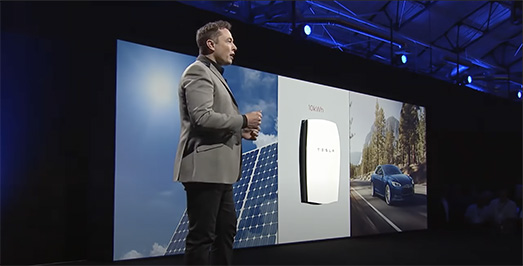
Ahh, Elon. It was a simpler time.
Since then, people always ask: Are solar batteries worth it?
When people ask me if solar is worth it, my honest answer is “hell yes” – unless they have a heavily shaded roof. But when it comes to batteries, it’s not as straightforward.
If you want a battery, it will be for one or more of these five reasons:
Reason #1) Blackout protection
Wild weather is getting more common, “one in a hundred year events” seem to be happening every year, and Australians are losing power more often. People living in areas particularly prone to blackouts value battery backup.
Properly designed and installed solar and batteries are a great way to protect your family from blackouts. Plus, it feels awesome when you’re the only house on the street with the lights on and the beers cold.

My house during a blackout. No candles needed!
Reason #2) Environment
Years ago, I would have told you adding solar panels to your roof was much better for the environment than adding a battery. But that has changed.
Australia is winning at solar power. We’ve got so much that, at times, there is more solar energy being exported than the grid can handle. At other times the grid is crying out for cheap, clean energy.
The biggest challenge Australia has in achieving a fully renewable grid is getting through the evening demand peak as the sun sets and everyone gets home and switches everything on.
A battery takes some of your daytime solar electricity and uses it to reduce this peak demand, helping us get to 100% renewables on the grid.
So, while we still need to add more solar capacity to help us get through winter and crappy weather – pairing that with a battery will give it the most bang for environmental buck.
Reason #3) Economics
Being honest about the economics of batteries leads people to accuse me of being ‘anti-battery’. On the contrary, I love batteries. I have one on my own home.
I simply don’t like how some dishonest companies sell them. Their savings are often wildly exaggerated and miscalculated, and often sold as a magic bullet without proper consideration of the solar, battery, and tariff combination that will give you the maximum savings.
Here are some ballpark numbers. A typical home battery on a standard tariff, with enough solar to charge it reliably through winter, will typically save between $500 and $950 per year.
If you are on a time-of-use tariff, the savings can be from $600 to over $2,000 per year, depending on how expensive the evening peak is. In 2025, I’m seeing tariffs that go as high as 75 cents per kWh from 5 p.m. to 9 p.m. Using a solar battery to power through those eye-watering prices quickly racks up your savings.
Reason #4) Revenge
Some people hate their electricity company. As a result, they are highly motivated to end their reliance on electricity retailers by going off-grid.
However, once people discover the cost of going fully off-grid, their convictions tend to waver.
Reason #5) Early adopters/tech nerds
Some people like solar battery tech and want to play with it regardless of the cost. I’m in this category!
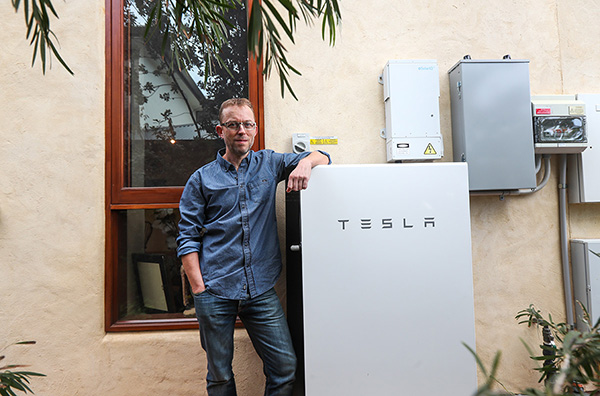
My Powerwall 2 and me.
The bottom line
Money isn’t everything.
Blackout protection, harsh export limits, or simply having a cool piece of tech in your home are also valid reasons to buy a home battery system. If any of these motivates you, I say go for it.
2) What can you expect to pay for a battery?
As I mentioned in Part 1, the size of a battery depends on how many kilowatt-hours (kWh) it can store.
As with solar panels, economies of scale kick in the larger you go with home energy storage. But, the effect is smaller.
Here are some examples of prices I’d consider reasonable:
- 5 kWh of storage: $7,000-$9,000 installed
- 10 kWh of storage: $10,000-$14,000 installed
- 15 kWh of storage: $14,000-$18,000 installed.
If you want to install the famous Tesla Powerwall battery, a Powerwall 2 has 13.5 kWh of storage and backup, and costs about $15,500 installed. It’s a great unit – if you can afford it.
Some homeowners mistakenly think solar battery installations are a “one size fits all” situation, where they take X amount of time to install, so they should cost Y.
This couldn’t be further from the truth – as with solar, the cost of installing a battery can vary wildly depending on several factors, such as:
- Distance between the battery and your switchboard (longer distance = more cabling = more expensive install).
- How many backup circuits do you want?
- If you want circuits backed up, are they all in the main switchboard or a sub-board within your home?
- Are new circuit breakers required? If so, how many?
- Are bollards or a fireproof backing needed to ensure a compliant installation?
- Is your home single-phase or 3-phase? 3-phase installs can quickly become complicated – and thus more expensive.
The difference in cost between an “easy” battery install and a challenging one can easily be a thousand dollars or more.
Pro-tip: You can see approximate installed solar battery prices here.
Note – you may see lower prices advertised online and in the paper. See point #8 of this guide for why I’d go nowhere near a cheap solar battery storage system.
Payback period
Some installers will present quotes showing a faster-than-typical battery payback.
Here’s an example of how they do it, taken from my solar and battery calculator:

Installers can ‘blend’ the faster payback of the solar panels (4.5 years) with the slower payback of the battery (12 years) to only show the simple payback of the system as a whole (8 years).
Rebates and Virtual Power Plants can further improve battery payback time – I discuss these in Section 4.
Pro-tip: My solar and battery calculator is the only one I know of that separates out the payback of solar and batteries instead of simply blending them together. If you want to calculate your savings when adding a battery to an existing system, I also have a separate battery calculator for that.
3) What Are The Best Solar Batteries?
The new generation of home batteries is still, well, new. This means long-term results are still thin on the ground. So, it’s important to choose a solar battery backed by a solid company that will be there for you if you run into issues. Based on feedback from our installer clients, the chart below shows all the brands we’d be happy to install on our own homes.

Pro-tip: Find reviews of each brand here: BYD | genz | Enphase | SolarEdge | iStore | PowerPlus Energy | Sungrow | Sigenergy | Tesla
4) What size battery system do you need?
The amount of storage you need to buy, in kWh, depends on your nighttime energy use.
The typical Australian home uses 16-20 kWh over 24 hours. For a 9-to-5 household, 60%+ of this electricity usage is between sunset and sunrise.
So to run your home off a battery system, the minimum size I’d recommend is 10 kWh. You’d also want at least 10 kW of solar panels to charge it reliably through the year.
Here is a much more detailed answer: How many solar batteries do I need?
A decent-sized battery starts at about $10,000. That has made people ask whether there are legitimate ways to pay less for one without compromising quality.
Well, there are a few ways to get a discount on a home battery system. Enter…
5) Rebates and VPPs – making batteries more affordable, at a cost.
There are two ways to pay less for a solar battery in 2025: a state or territory rebate, and Virtual Power Plants (VPPs)
Rebates
At the time of writing, WA is the only state offering a battery rebate. It’s worth approximately $130 per kWh and $380 per kWh in regional WA.
If you join a VPP in NSW, you’re entitled to an extra $55 per kWh.
Virtual Power Plants (VPPs)
There are also Virtual Power Plant schemes available in most states.
If you sign up for a VPP, you give up full control over your battery as sometimes the VPP will operate it. How often this happens depends on which one you join.
Two advantages of VPPs:
- You may get an upfront discount on a battery system by agreeing to join a VPP when you buy.
- You can get paid a bonus for charging or discharging the battery at times when the grid needs support. With some VPPs, this may substantially improve the battery’s economics.
Two drawbacks to joining a VPP:
- The more your home battery is used, the shorter its lifespan. (Tesla has recognised this concern and is extending their warranty by 5 years if you join a particular Tesla VPP.)
- Stored energy is usually most valuable in the evening peak. VPP operators may force your battery to charge from the grid in the mid-afternoon and discharge into the grid shortly after sundown, leaving you with little or no energy storage to get you through the night.
Pro-tip: I’ve written about Virtual Power Plants in detail here.
6) Common techniques of dodgy battery salesmen
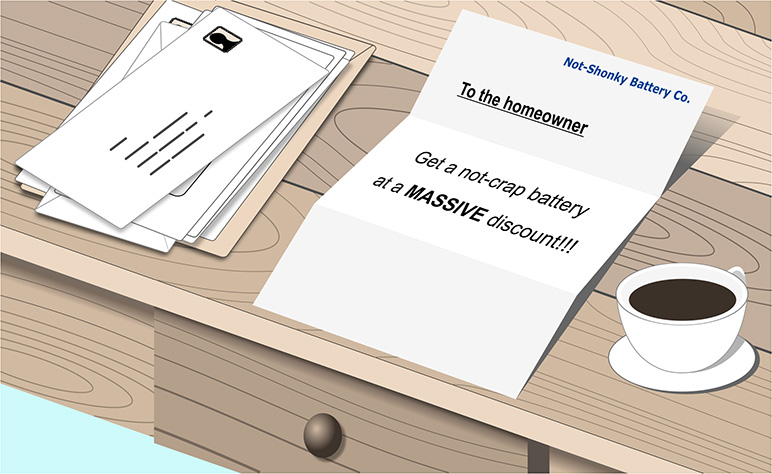
Many honest companies ethically sell batteries. They take the time to run you through the pros, cons, and economics.
But – as with any new bill-reducing technology – they also attract bad salespeople. They see an opportunity to cash in on consumer confusion: promise the world and bag a hefty commission.
Here are the go-to tactics of dodgy battery salespeople:
Technique #1) Promising $0 bills with small batteries and small solar
Smooth-talking battery salesman promising $0 electricity bills are all too common. With enough solar and a big enough home energy storage system, anyone’s bill can go to zero.
Often, hard-selling salespeople don’t even sell a big enough battery system to get a homeowner’s bills to zero, or even care if the owner has enough solar panel capacity to charge it through the year. Instead, they sell a small (sub-6 kWh) energy storage system with a fat commission.
Technique #2) Bait & Switch
A classic tactic is to quote cheap to secure your business. Then, on installation day, they’ll demand thousands more to finish the installation.
Technique #3) False Scarcity
Another tactic is a letterbox drop inviting you to join a ‘closed-group battery test’, offering home energy storage at a ‘substantial discount’.
And wouldn’t you know it – there are only a few places left, so you need to get in quick!
My advice here is simple – if something sounds too good to be true, it usually is.
7) Battery backup – know what you should be asking for
What type of backup do you want?
If you are buying a solar battery system – you should make the most of it. Ensure it is installed and configured so it backs up some, or all, of your home. But be careful when you ask for backup, as you may not get what you expect.
I’ve put together this description of the ‘levels’ of home battery backup to help you understand what to ask for:
- Level 0 – No backup at all.
- Level 1 – Provides backup, but the battery has reduced capabilities (such as lower power output).
- Level 2 – Provides backup with full functionality during a blackout. But, your batteries can’t charge from your solar power system when the grid is down. This can be annoying if a blackout hits during the daytime when your energy storage is running low!
- Level 3 – “Apocalypse proof” backup. Full battery functionality, and you can charge your batteries from your solar panels while the grid is down.
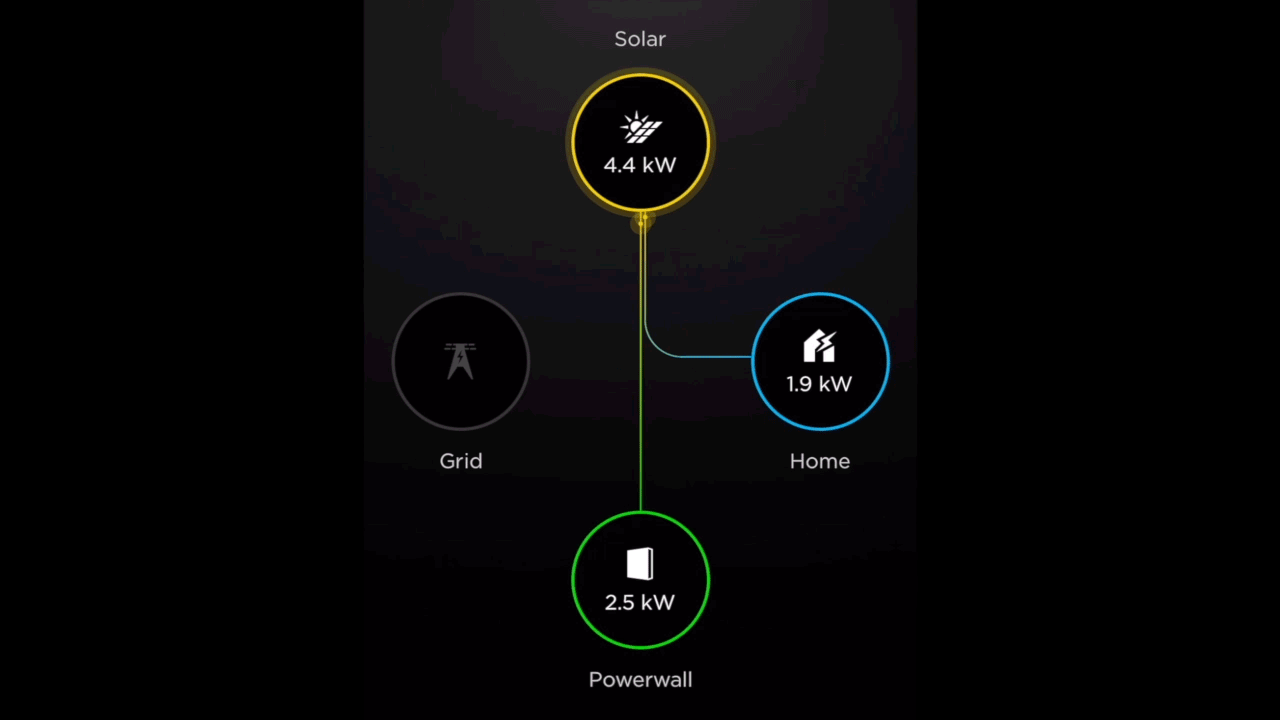
My home operating with ‘level 3’ backup
In my opinion, if you buy an energy storage system, you want it to provide level 3 “apocalypse-proof” backup.
Say to your installer, “I want my batteries to charge from my solar panels when the grid is down”.
If you have a tricky install, ‘level 3’ backup might not be possible in rare cases. Your installer will talk you through your options.
What circuits do you want to back up?
Although some manufacturers (hello Tesla!) market their batteries as ‘whole house backup’, I recommend only backing up your essential circuits.
If your battery is simply wired to backup your whole home, this can happen:
- You don’t even notice the power has been cut
- You use your heating/cooling/hot water/oven/pool pump as usual.
- Your battery either overloads on power demand or runs out of energy within a few hours.
- You are as blacked out as the rest of the street.
My battery backs up the lights, kitchen (except the oven), and air conditioner in my house. So if I have a power cut it’s obvious, and I know to use my electricity carefully – especially the air conditioner.
So talk to your installer about what circuits you consider essential – and only back those circuits up. Also, take the time to learn how much power those essential appliances use and how long they can run without draining your battery.
8) “Thermal runaway”, aka “Why you shouldn’t buy a cheap battery”.
Because solar battery storage is expensive, people always want to find a cheaper option. After all, they are all the same, right?
Wrong.
Lithium-based batteries can store large amounts of energy. When they charge and discharge, they generate heat. If charging and discharging are not managed correctly, or there is an electrical fault, “thermal runaway” can occur. Thermal runaway is a fancy way of saying “a big-ass fire”. As there’s a large amount of flammable material inside lithium batteries and a restricted oxygen supply, they can burn for hours.
There are two common types of lithium battery. Confusingly, they are both lithium-ion batteries, but one also contains iron. Specifically, they are:
- lithium-ion: NMC
- lithium-ion: lithium-iron (also called LFP or LiFePo4)
NMC catches fire more easily and will burn for longer than lithium-iron, but be wary of any salesperson who tells you their lithium battery ‘can’t catch fire’. They can, and such complacency is dangerous.
Different manufacturers have different ways of keeping their batteries safe over the decade or two they’ll be in service. But this requires properly funded research and development teams.
For me, this is deadly serious. Cheap batteries installed for peanuts worry me.
Don’t gamble with your safety to save money on a solar battery storage system. If you can’t afford a decent brand, don’t buy one at all.
9) AC versus DC coupling
See part 1 of my guide for a more in-depth AC/DC coupling explanation.
When it comes to buying a battery system, there are some key differences between AC and DC coupling:
AC Coupling
- Solar inverter agnostic – technically, you can retrofit any battery to any existing solar system.
- Requires a ‘battery inverter’ alongside your solar inverter, which adds to costs. (Some, like the Powerwall 2, come with an inbuilt battery inverter).
- It can be expensive or impossible to get level 3 backup if you’re on 3-phase power.
- Due to DC > AC > DC conversion losses, most AC-coupled batteries have a round-trip efficiency of ~88%.
- DNSP limits on single-phase houses may mean you’re not permitted to add an AC-coupled solar battery. It depends on whether the DNSP counts the battery inverter towards your total phase limit.
DC Coupling
- Requires a hybrid inverter.
- Limits your choice of energy storage systems to the battery models your inverter supports.
- Some inverters cannot provide level 3 backup.
- A risky option if you’re planning on adding energy storage later. New batteries may not be compatible with your inverter.
- Marginally higher efficiency compared to AC coupling – up to 95%.
DC coupling is preferable if you have your heart set on a specific inverter/battery combo and want to buy now. However, AC coupling is the way to go if you want flexibility in your choice of solar battery storage.
But – make sure your local network doesn’t count the battery inverter toward your inverter limit.
10) Batteries degrade faster than solar panels.
Solar panels have 25 or 30 year ‘performance warranties’. This warranty states they won’t degrade more than a certain amount per year.
Most batteries have ten-year warranties. Only a few (expensive) home energy storage systems have warranties longer than this.
The typical budget-end solar panel is permitted to degrade by about 0.5% per year over 25 years. The typical battery warranty allows it to degrade by 3-5% per year.
Batteries degrade with time and with use. Anyone with a mobile phone will have experienced this degradation.
Once a solar battery reaches the end of its warranty, degradation is not linear. Sharp declines are likely, especially once its capacity drops below 60%.
Let’s use the Tesla Powerwall’s warranty as an example. It says the battery will provide 70% of its initial 13.5 kWh capacity after ten years. This works out to a little over 3% annual degradation.

A screenshot from the Powerwall’s warranty.
I’ll guess the further it gets past the end of its warranty, the greater the annual drop will be. As it’ll be another few years before any Powerwall 2 gets to ten years old, we’ll have to wait and see if I’m right.
Pro-tip: Many models of solar battery financial payback assume no degradation – and it should be included.
Take the time to understand your solar battery’s warranted performance and degradation. Then, ensure your expectations of the home battery system’s performance toward the end of its warranty are realistic.
11) Battery warranties – what to look for
Reading battery warranties can be tedious. I know because I’ve read a bunch. Here are the key points to understand about any energy storage system you’re thinking of buying.
Battery degradation
What capacity does the battery have at the end of its warranty? 60% after ten years is a typical amount. Look favourably on any company warranting more than 60% after ten years.
Also, ask: Is your warranty the same if you’re a part of a VPP? Tesla, for example, warrants their batteries for “unlimited” cycles in residential use. But, if you’re part of a non-Tesla VPP, they only warrant 2,800 full cycles – which can be used quickly!
“Gotchas”
- Are there any clauses in the warranty reducing what’s covered or which void it entirely?
Some warranties don’t allow you to cycle a battery more than once per day. Others void the warranty if the ambient temperature goes outside a narrow range. Some mandate the battery must always have an internet connection. Finally, some require online warranty registration shortly after installation.
- Does the warranty cover the entire battery or only parts of it?
A classic example is a ten-year warranty for the battery, but only five years for the supporting electronics. If something important breaks in year six – you’ve got a hefty repair bill coming up.
- Do extended warranties also increase the number of cycles allowed?
I saw a solar battery manufacturer trumpet their batteries’ industry-leading 20 year extended warranty. But purchasing this extended warranty didn’t increase the amount of energy you could use. All it did was give you an extra ten years to use it.
- What does the manufacturer cover for a warranty replacement?
Some manufacturers cover labour costs involved with diagnosing and repairing a solar battery. Others don’t. Some have a clause stating if they deem the battery ‘beyond repair’, they’ll compensate you financially based on the age of the unit. This compensation can be stingy.
Pro-tip: Read the warranty document carefully. Some manufacturers have very stingy compensation – one major brand I saw will only compensate 2% of the battery cost in its ninth year.
Who’s backing the warranty?
This is a big one. Ideally, a battery brand would have an established Australian office. Meaning they can’t pack up and slink home to wherever to shirk their responsibilities.
Many companies have started to import and sell batteries from overseas. There’s nothing wrong with this. But, ask yourself – how likely is it a small importer will be operating in ten years?
Pro-tip: My solar battery comparison table has links to the warranty documents for all listed batteries.
12) What to consider for an optimal installation
Where is the battery going to go?
If you need your solar battery installation to be some distance from your meter box, be aware the cost of cabling can add up quickly. The difference in price between installing it next to the meter box and somewhere else in your house can be a grand or more.
Battery standards are strict on where you’re allowed to place one.
For example, you cannot install a battery under stairs or access walkways, in roof or wall cavities, or in a ‘habitable room’.
You’re also not allowed to install a battery within 600mm beside or 900mm below:
- An external exit (a door going out of a building)
- A window
- Building ventilation for a habitable room
- A non-associated appliance, like a hot water tank or air conditioner unit
Also consider:
- Will your switchboard need an upgrade to accommodate the extra battery equipment? Depending on the size of the upgrade, this can add thousands to a quote.
- Is your solar array big enough to charge the battery, even in winter? The bigger the battery, the more solar panels you’ll need to charge it and power your home.
- What circuits in your house do you want to back up?
As already explained, it is often better to only back up select circuits instead of your whole house. The less you back up, the longer you can run them in a blackout. If your batteries are charging from your solar panels (‘level 3’), you can run these circuits for quite some time!
Also, will it be installed in a garage? Then you’ll need bollards or other protection installed for safety reasons:
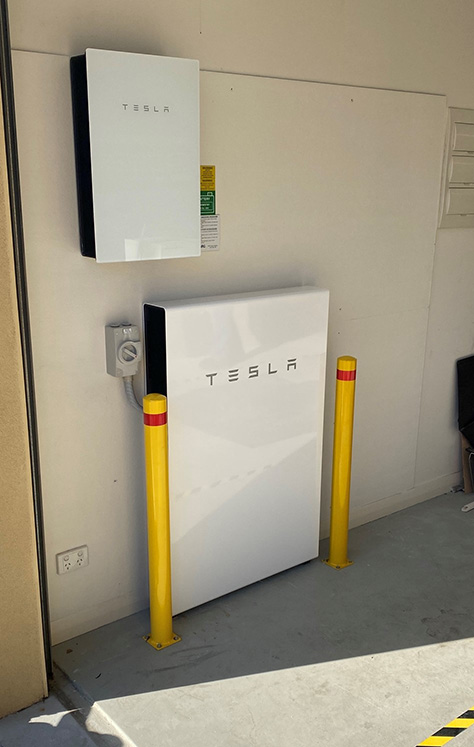
Tesla battery installed on a fire-proof backing, with bollards.
The next step
I hope you found this guide to buying solar batteries useful. In Part 3 of this series, I look at owning a solar battery system – how to make the most of it. If you have any questions about home energy storage, my contact details are:
Email: [email protected]
Tel: 08 7200 0177
Snail mail: 3/39 Grenfell St, Adelaide, SA 5000 Australia
If you’re ready to buy a home battery, I can help you get quotes from high-quality, trusted installers quickly and easily:

Finn Peacock, founder of SolarQuotes.com.au